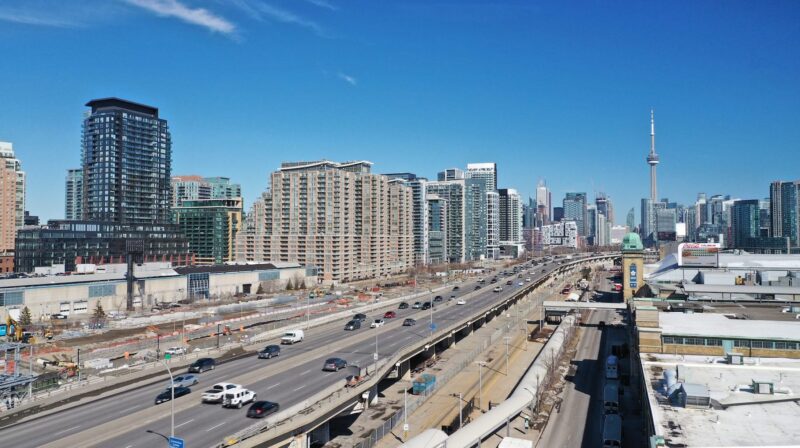Between its crumbling infrastructure and perpetual gridlock, Toronto’s infamous Gardiner Expressway has seen better days. That, we can all agree upon. Simultaneously, we can also agree that the rapidly densifying city has become maddening on the construction front – especially as we (eventually) approach the warmer months.
At times, it’s virtually impossible to move from point A to point B. It’s a frustrating situation that most of us are familiar with: it’s a beautiful and balmy night in Toronto, and the city is full of life, with a Blue Jays Game, a hot-ticket concert at Budweiser Stage, and the Canadian National Exhibition (CNE) in full force. This can only mean one thing: the Gardiner Expressway is in a virtual stand-still.
The congestion, however, is just one issue. The overused urban highway is literally falling apart at the seams (complete with documented cases of falling concrete), thanks to years of wear and tear. So, the City of Toronto is doing something about it.
ADVERTISEMENT |
Most recently, it was announced that the Gardiner would be reduced to two lanes in both directions between Dufferin Street and Strachan Avenue – for three years of rehabilitation. It will also close the eastbound on-ramp to the Gardiner Expressway from Lake Shore Boulevard east of Jameson Avenue during construction. That’s not all: according to a construction notice, intermittent, additional lane closures will be required during the project.
The work – and its anxiety-inducing lane reductions – is expected to begin mid-March. And, no, Toronto residents aren’t thrilled about it (just check social media or Reddit).

The initiative is part of the City of Toronto’s Gardiner Expressway Strategic Rehabilitation Plan. It was approved nearly a decade back and addresses the immediate and long-term rehabilitation needs of the entire expressway, from Highway 427 to the DVP, to help ensure it remains in a safe and operable condition, now and in the future. In short, the aging highway is approaching the end of its original design life.
“The Gardiner Expressway is more than 60 years old and parts of the Expressway are in critical condition due to the effects of age, heavy daily use, weather, and salt, making it necessary to undertake a major multi-year rehabilitation to keep it operational for the future,” says Hakeem Muhammad, Senior Communications Advisor for the City of Toronto. The bottom line is there’s simply no other choice. It’s sort of like wearing a cast to heal a broken bone: it sucks and is inconvenient, but needs to be done.
ADVERTISEMENT |
Stage one of the six-part rehabilitation plan involved rehabilitation from Jarvis Street to Cherry Street and was completed in 2021. This work included the rehabilitation of the westbound off-ramp that leads to Yonge, Bay, and York Streets, the replacement of the entire concrete deck and steel girders of the Expressway between Jarvis Street and Cherry Street, and the replacement of the westbound both the westbound off-ramp at Sherbourne Street and the eastbound on-ramp at Jarvis Street.
The work between Dufferin and Strachan is part two of the rehabilitation plan, which was approved by City Council between 2014 and 2016. The work will essentially replace the elevated portion of the Expressway from Dufferin to Strachan.
“The work includes replacing 700 metres of the road’s surface and all the structures underneath that support it,” says Muhammad. “A new traffic management system and streetlights will also be added. The rehabilitation of this stretch is complex as the roadway is elevated, very narrow, and busy. Drivers may not see workers along the Gardiner during road closures, as much of the work will be done from underneath.” Muhammad makes a good point to those feed-up Toronto residents who throw up their hands in frustration when they see construction signs of construction but no construction workers.
Muhammad says that the City is working to balance critical construction with the needs of people and businesses using Toronto’s roads. “While the City recognizes there will be impacts to residents and commuters, completing this state of good repair project is critical to ensure the safety of all road users, commuters, and residents of Toronto,” says Muhammad. “Staff have assessed all work planned in the area and have identified the critical work that needs to proceed imminently.”
According to Muhammad, the local neighbourhood and affected parties are well-informed on the initiative.
ADVERTISEMENT |
“The City is coordinating this critical work with local businesses, BIAs, utility companies, event organizers and other impacted groups and individuals in the area to carry out construction in a timely manner and reduce impacts as much as possible,” says Muhammad. “The City also coordinates with TTC, Metrolinx, and other partners on traffic management plans during major events. For example, the City has structured the Gardiner contract from Dufferin Street to Strachan Avenue to pause construction during the FIFA World Cup. The lane restrictions will be removed from May to the end of July 2026 to allow for full capacity of the Expressway during the tournament.” That’s a sigh of relief for soccer fans.
“The City is committed to addressing traffic congestion to help all road users get around the city safely by working to balance critical construction with the needs of people and businesses using Toronto’s roads,” continues Muhammad. As for the TTC and GO Transit, according to the construction notice, both will operate on regular schedules. With that said, it also states that there will be times during construction when the 509 and 511 TTC Streetcars will operate using a shuttle bus to access the TTC Exhibition Loop platform due to overhead work above the streetcar loop.
Similarly, pedestrian access on Manitoba Drive and through the Exhibition GO Station connecting Atlantic Avenue to Manitoba Drive will be maintained. However, there will be times when the pedestrian access between Atlantic Avenue and Manitoba Drive through Exhibition GO Station will be closed for overhead work.
ADVERTISEMENT |
While the City seems to be doing all it can to make life as easy as possible during the rehabilitation, the bottom line is that the work will cause traffic headaches for those coming in and out of the city or trying to get across town via the Gardiner. But there’s really no other choice. So, we just need to accept it and give ourselves a little extra time to get to the airport – and anywhere, really (pack your patience).






